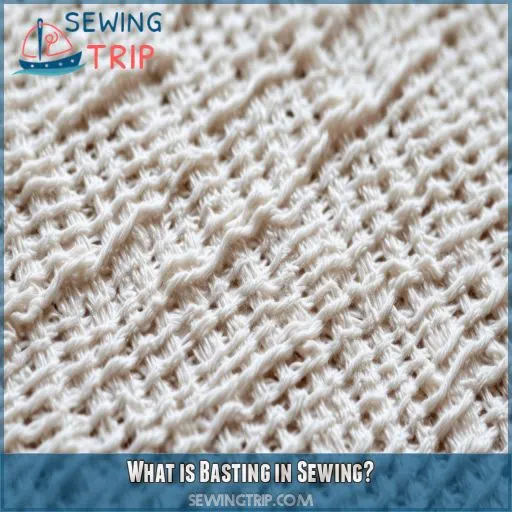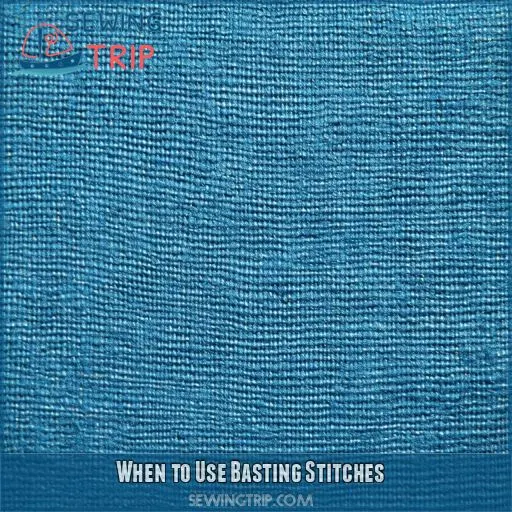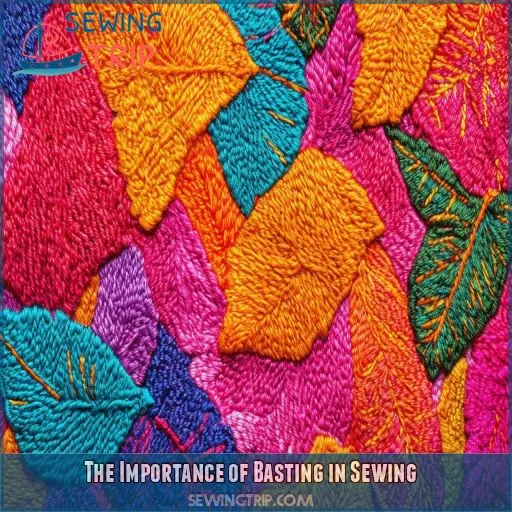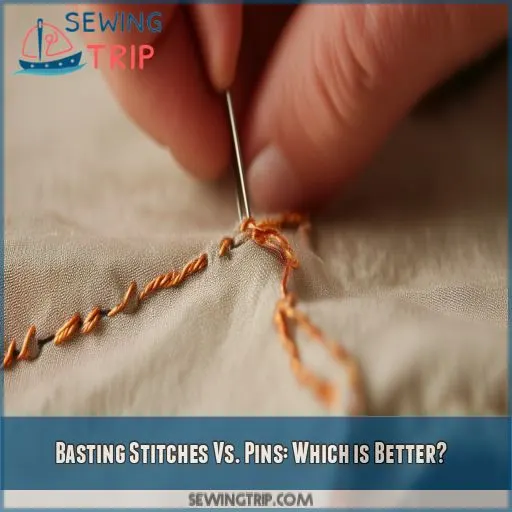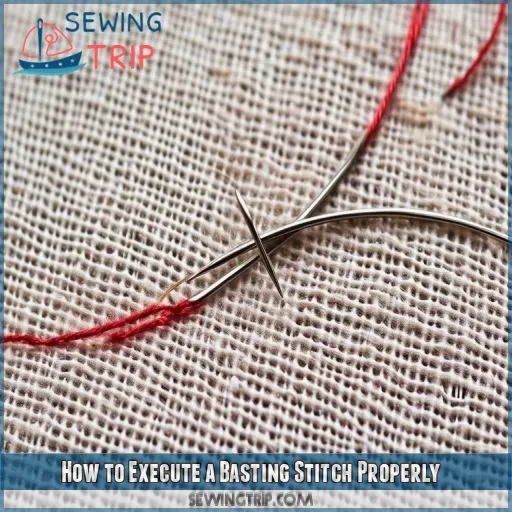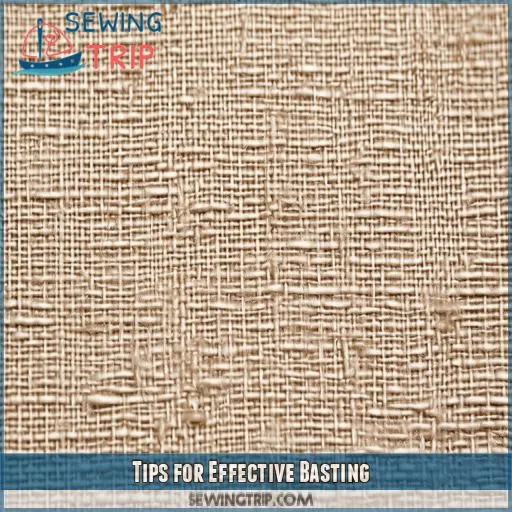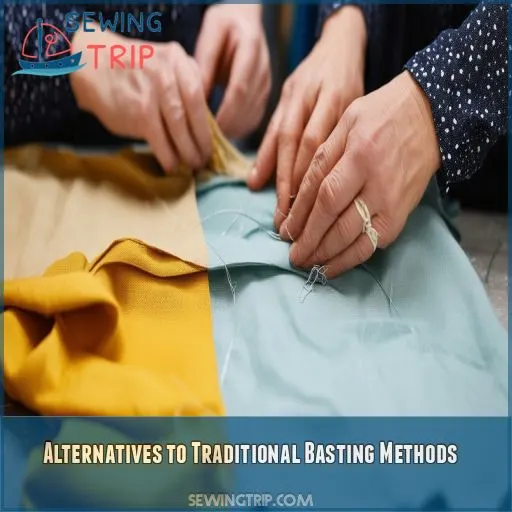This site is supported by our readers. We may earn a commission, at no cost to you, if you purchase through links.
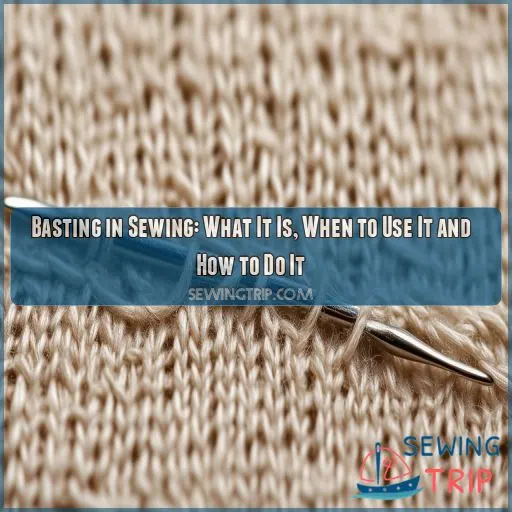
Basting, a temporary stitch, is a handy technique to secure fabric layers before permanent stitches. This simple method prevents slipping and ensures precise sewing. From sleeves to zippers, basting adds stability, especially with delicate fabrics like silk.
But what’s the best way to baste? Can you use a machine or is hand-stitching necessary?
Get ready to master basting and elevate your sewing skills!
Table Of Contents
- Key Takeaways
- What Does Baste Mean in Sewing?
- What is Basting in Sewing?
- When to Use Basting Stitches
- Differences Between Hand and Machine Basting
- The Importance of Basting in Sewing
- Basting Stitches Vs. Pins: Which is Better?
- How to Execute a Basting Stitch Properly
- Tips for Effective Basting
- Alternatives to Traditional Basting Methods
- Frequently Asked Questions (FAQs)
- Conclusion
Key Takeaways
- Basting is a warm embrace for your fabric, temporarily holding it in place before the real sewing begins.
- It’s not just for beginners; even seasoned sewers use this technique to stay on course.
- Think of basting as a GPS, navigating your needle down the correct path.
- It’s a timesaver, too, as it spares you from the hassle of dealing with pins.
What Does Baste Mean in Sewing?
Basting in sewing is a pre-stitching technique that temporarily holds fabric together, ensuring accuracy in your sewing projects. It provides a guideline for permanent stitches, guaranteeing a perfect fit. You can baste by hand or with a machine, and it’s an essential step when attaching sleeves, constructing garments, gathering fabrics, inserting zippers, or quilting.
Stay tuned to learn more about the importance of basting and how to execute it properly.
What is Basting in Sewing?
Basting is a pre-stitching technique used to temporarily hold fabric together. It’s an essential step in sewing as it provides a guideline for permanent stitches and guarantees accuracy in your project. Whether you’re a beginner or a seasoned sewist, basting is an indispensable skill to master.
You can baste fabric by hand or with a machine, and the stitch length should be at least five. Hand basting gives you greater control over stitch length, while machine basting is ideal for adding extra fabric over curves. Regardless of the method, the key is to work quickly and efficiently, without worrying about perfect stitching.
Basting saves time and prevents interruptions from removing pins. It’s especially useful when working with slippery or velvety fabrics, as it keeps your material securely in place. Additionally, basting is a must for garment fitting, allowing you to confirm a perfect fit before committing to permanent stitches.
When to Use Basting Stitches
Use basting stitches when attaching sleeves, constructing garments, gathering fabrics, inserting zippers, and quilting to guarantee precision and stability. These stitches help hold fabrics temporarily, making them easier to manipulate and secure before permanent stitching.
Sleeves
Basting stitches are essential when attaching sleeves to armholes, ensuring a precise fit.
This technique is especially useful for sleeve fitting, sleeve construction, and sleeve attachment.
When dealing with sleeve plackets, lining, or intricate details, basting provides control and accuracy.
You can use basting stitches to temporarily hold the sleeve in place, allowing for adjustments before committing with permanent stitches.
This prevents errors and ensures a neat finish.
Garments
Basting stitches are critical when working with garments, especially when attaching sleeves to armholes.
This technique prevents slipping and ensures accuracy, making it easier to remove than machine stitches.
It’s a time-saving method that allows you to fit garments without the interruption of removing pins.
Basting stitches are also useful when working with multiple fabric layers or delicate materials like lace.
Gather Fabrics
Basting stitches are essential when gathering fabrics, especially for creating ruffles and adding volume to your projects. Here are three key points to note when using basting stitches for gathering fabrics:
- Fabric Selection: Basting stitches work well with a variety of fabrics, but they’re particularly useful for slippery or delicate fabrics that can be challenging to manage.
- Precise Gathering: Basting stitches provide a temporary hold, allowing you to adjust and distribute the gathers evenly along the fabric.
- Easy Removal: Unlike machine stitches, basting stitches can be easily removed, giving you the flexibility to make adjustments as needed without leaving permanent marks on your fabric.
Zippers
Zippers can be a tricky business.
Basting stitches are your secret weapon. They act as a temporary hold, keeping your zipper in place as you sew.
This is especially useful for invisible zippers or detailed zipper designs.
Basting stitches offer the flexibility to adjust and align the zipper before committing to permanent stitches.
This technique ensures a precise and flawless zipper installation every time, whether you’re crafting a garment, a bag, or any other zippered creation.
Quilting
Quilting is an art form that requires precision and attention to detail.
When creating a quilt, basting stitches are essential. They provide a temporary hold, allowing quilters to adjust and perfect the pattern before committing to permanent stitches.
Basting stitches are used to attach bias tape and secure all the layers of the quilt together. This technique ensures that the layers stay put, creating a polished and professional finish.
Differences Between Hand and Machine Basting
Hand basting gives you precise control over stitch placement, making it useful for intricate or curved pieces. Machine basting is faster, ideal for straight edges, and involves using long stitches that are easy to remove.
Hand Sewing
Hand basting gives you more control over stitch length and fabric alignment. You can also adjust thread tension and needle choice as needed.
To hand baste, use a strong polyester thread and double-thread your needle. Then, create a running stitch with stitches about 1/4 to 1/2 inch apart. Secure the ends with a knot or backstitch. This technique is perfect for setting in sleeves and joining curved pieces.
The hand basting stitch is a temporary stitch, so it’s easy to remove. Simply snip the thread and gently pull it out.
Machine Sewing
Machine basting is a faster alternative to hand basting, especially when working with straight pieces of fabric. Here are some key differences and tips:
- Basting techniques: Pin fabric edges together lightly before sewing.
- Basting thread and needles: Use regular thread and needles, but avoid backstitching for easy removal.
- Long stitches: Sew inside the seam allowance with long, straight stitches.
- Basting fabric: Machine basting is ideal for straight fabric pieces, while hand basting offers more control for curves.
The Importance of Basting in Sewing
Basting is essential in sewing for several reasons, and its importance becomes evident when working with certain fabrics, fitting garments, and ensuring overall accuracy. Here’s why basting is so important:
| Type of Basting | Application | Benefits |
|---|---|---|
| Basting for Beginners | Holding Fabric Together | Temporary hold for accurate stitching |
| Basting for Curves | Sewing Curved Pieces | Allows for precise control when joining curved sections |
| Basting for Slippery Fabrics | Handling Silk or Velvet | Prevents slipping and ensures stability during stitching |
| Basting for Accuracy | Fitting Garments | Provides a guideline for permanent stitches, guaranteeing a perfect fit |
Basting Stitches Vs. Pins: Which is Better?
Basting stitches and pins both have their pros and cons, and the best choice depends on the specific sewing project and your personal preferences. Here’s a comparison to help you decide which technique to use:
Convenience: Basting stitches offer the convenience of not having to remove pins as you sew, especially with slippery or velvety fabrics. Pins can interrupt your flow.
Speed: Pins are faster to apply and remove for quick projects. Basting stitches take longer but can save time by eliminating pin removal during sewing.
Cost: Basting stitches use more thread, increasing costs, especially with specialty threads. Pins are reusable and more cost-effective long-term.
Aesthetics: Basting stitches are more visible, beneficial for seeing stitching lines. Pins leave smaller holes, ideal for flawless finishes.
How to Execute a Basting Stitch Properly
To execute a basting stitch properly, whether by machine or by hand, you need to understand the nuances of each method. Machine basting involves setting your machine to a long stitch length and sewing without backstitching for easy removal, while hand basting requires using large, evenly spaced stitches with a strong, double-threaded needle.
By Machine
Regarding machine basting: focus on straight fabric pieces.
Lightly pin the edges, then sew inside the seam allowance.
Use long, straight stitches with a stitch length of at least five.
Do not backstitch. This will make it harder to remove the basting stitches later.
Machine basting is a common technique in sewing patterns, especially when adding extra fabric over curves.
By Hand
When basting by hand, use strong polyester thread and double-thread it. Opt for a running stitch with stitches that are 1/4 to 1/2 inch apart. Secure the ends with a knot or backstitch. This technique is perfect for setting in sleeves and joining curved fabric pieces. It provides the precision needed for basting curves.
Tips for Effective Basting
Now that you know how to execute a basting stitch, here are some tips to make sure your basting is effective:
- Choose the right basting technique for the fabric: Hand basting offers more control over stitch length, making it ideal for intricate work like setting in sleeves and joining curved pieces. Machine basting, on the other hand, is better suited for straight pieces of fabric and adding extra fabric over curves.
- Avoid placing basting stitches on the machine stitch line: This will make it easier to remove the basting stitches later and prevent any interference with your final stitches.
- Use a contrasting thread color: Opt for an old or differently colored thread for basting. This makes it easier to see and remove your basting stitches, guaranteeing you don’t accidentally sew over them.
Alternatives to Traditional Basting Methods
While basting stitches are essential, there are times when you may want to try alternative methods to secure your fabric. Here are some options:
- Basting Clips: These are specifically designed for holding multiple layers of fabric together and can be a quicker alternative to basting stitches.
- Improvised Basting: Everyday items like paper clips, hair clips, or pegs can be used in a pinch. They may not provide the same level of security as basting stitches, but they can be a quick fix.
- Basting Spray and Glue: For a more temporary hold, you can use basting spray or fabric glue, especially when working with delicate fabrics that might be damaged by stitches or clips.
- Double-Sided and Iron-On Tapes: These provide a quick fix and easy way to secure your fabric, but they may not be suitable for all projects, especially those that require a more permanent hold.
Frequently Asked Questions (FAQs)
How do you baste when sewing?
To baste by hand, use a running stitch and insert the needle at the fabric’s edge. For machine basting, adjust the stitch length to 4 or 5, and sew along the fabric’s edge.
What does the term baste mean in sewing?
Oh, so you want to be a sewing superstar? Well, let’s start with the basics. Basting is a simple technique used to temporarily hold two or more pieces of fabric together before machine sewing. It’s like a big hug for your fabric, keeping everything nice and snug until you’re ready to sew.
Is basting necessary in sewing?
Basting is necessary when working with delicate or slippery fabrics, ensuring correct alignment, and when checking the fit of a garment. It’s also useful for sewing zippers and appliqueing.
What tension should a basting stitch be on a sewing machine?
Set your machine to the longest stitch length, at least Loosen the tension so you can pull out the thread easily. The stitch length will depend on your fabric’s thickness.
How does basting save time?
Basting saves time by securing fabric together temporarily, preventing interruptions from removing pins. It’s a quick, efficient way to hold fabric in place, providing a guideline for permanent stitches, so you can sew with speed and accuracy.
What stitch length should be avoided for basting?
When basting, avoid stitch lengths under 0. For hand basting, use a long running stitch. For machine basting, set your stitch length to the longest setting, typically between 4 and
What are the advantages of hand basting over machine basting?
Hand basting gives you more accuracy and control over your project, especially when working with difficult fabrics like velvet, chiffon, or charmeuse. It’s also faster and easier to remove hand basting stitches than machine basting.
Can basting stitches be used for all types of fabric?
Basting stitches are great for fabrics that are difficult to hold together with pins, like silk, velvet, and slippery fabrics. However, they can be used on most fabrics, offering more stability than pins alone.
What are some tips for effective basting?
For effective basting, use loose, uneven stitches. You can use pins or clips to hold layers in place. Adjust the stitch length to 4 or 5 on your machine. If you plan to remove stitches, use a contrasting thread color.
Conclusion
Sewing enthusiasts, rejoice!
You now understand the importance of basting: a temporary stitch technique.
This method is essential for securing fabric layers before applying permanent stitches.
You have mastered when and how to baste, whether by hand or by machine.
You have also explored alternatives to traditional basting methods.
So, whether you are a novice or a pro, you are now equipped with the skills to elevate your sewing projects.
Happy stitching!

